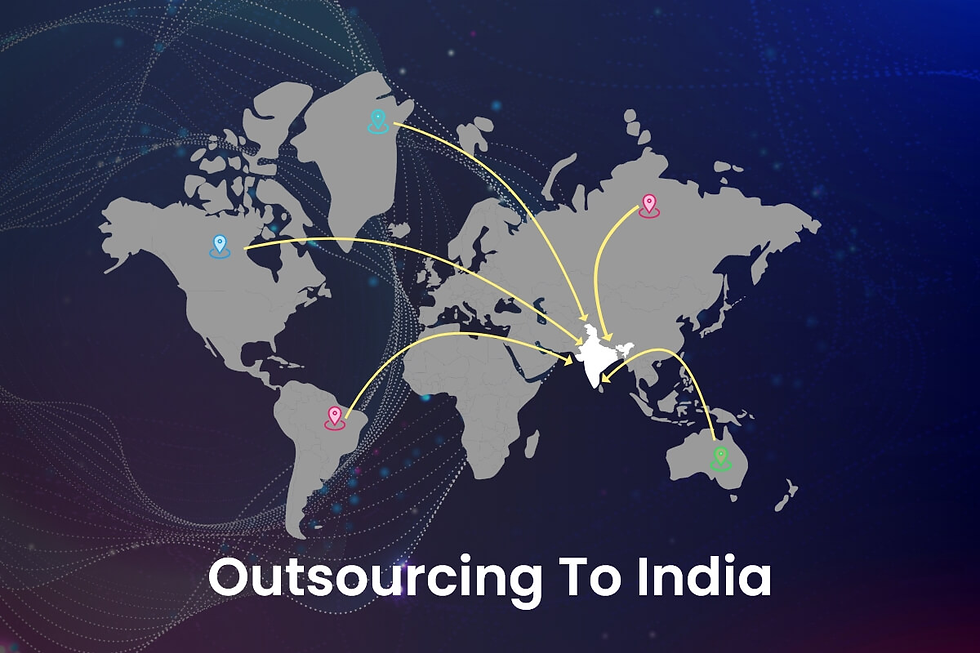IT Outsourcing to India: Opportunities, Risks, and What to Do Instead
- Jayant Upadhyaya
- Aug 21
- 4 min read

Outsourcing IT services has been one of the most transformative trends in global business over the last three decades — and India has been at its center. From software development and application maintenance to helpdesk support and cloud integration, Indian IT outsourcing firms have served as strategic partners for startups, SMEs, and Fortune 500 companies alike.
However, the outsourcing landscape in 2025 is far from static. The rise of AI-powered development tools, increasing concerns over security and intellectual property, and the growth of nearshoring alternatives have led many decision-makers to rethink their strategies.
In this guide, we’ll cover:
Why India became the world’s top IT outsourcing destination
Key opportunities Indian outsourcing still offers
The risks and downsides you should consider
What to do instead — alternatives and hybrid models
How Synlabs can help as a smarter outsourcing partner
1.Why India Became the Go-To Destination for IT Outsourcing
India’s dominance in IT outsourcing didn’t happen overnight. Several factors converged to make it the global leader.
1.1 Cost Efficiency
Labor costs in India are significantly lower than in North America, Western Europe, and Australia. A software engineer in India may cost 30–50% of what a similarly skilled professional would cost in the U.S.
1.2 Large Talent Pool
India produces over 1.5 million engineering graduates annually, many specializing in computer science, information technology, and related fields. The country also has a robust mid- to senior-level talent base for project management and architecture.
1.3 English Proficiency
English is widely spoken in India’s tech sector, easing communication with Western clients.
1.4 Government Support
Policies such as tax incentives for IT parks and export-oriented units (EOUs) have encouraged the industry’s growth.
2. Opportunities in Outsourcing IT to India
Despite growing competition from other countries, India still offers significant advantages for the right businesses.
2.1 Access to Specialized Skills
From cloud migration to AI model training, Indian IT firms have expanded beyond traditional coding into specialized, high-demand areas.
2.2 Scalable Teams
You can quickly ramp up a team from two to 20 developers without the long hiring cycles of in-house recruitment.
2.3 24/7 Operations
With the time-zone difference, companies in North America and Europe can have “follow-the-sun” development and support models, ensuring work continues after their own business day ends.
2.4 Mature Outsourcing Infrastructure
From large IT parks in Bangalore to robust broadband and data security frameworks, the infrastructure supports complex projects.
3. Risks and Challenges of Outsourcing to India

Outsourcing to India is not without pitfalls. Businesses need to weigh these before committing.
3.1 Communication Gaps
While English is common, cultural differences and time zone lags can slow decision-making and lead to misunderstandings.
3.2 Quality Variability
The Indian IT market is huge — which means quality can vary drastically between vendors. Some firms deliver world-class results; others overpromise and underdeliver.
3.3 Security and IP Concerns
Data security regulations in India are improving, but IP protection can still be a concern, particularly for sensitive or proprietary projects.
3.4 Turnover and Talent Retention
Top developers in India are in high demand, leading to high attrition rates and potential disruption in ongoing projects.
3.5 Hidden Costs
Travel, training, and management overheads can erode the cost savings if not managed carefully.
4. Red Flags When Choosing an Indian Outsourcing Partner
Before signing a contract, look for these warning signs:
No clear portfolio or client references
Reluctance to sign strong NDAs or IP agreements
Lack of defined project management processes
Overly aggressive timelines that seem unrealistic
High employee churn rates
5. Alternatives to Traditional Outsourcing in India
If the risks seem too high, there are alternative models worth exploring.
5.1 Nearshoring
Hiring teams in countries closer to your own — such as Eastern Europe for Western Europe or Latin America for North America — can reduce time-zone and cultural barriers.
5.2 Hybrid Teams
Mix in-house core staff with outsourced developers from India or other countries. This allows you to keep sensitive work internal while still benefiting from global talent.
5.3 On-Demand Development Platforms
Modern platforms allow businesses to tap into vetted developer networks or even use no-code/low-code solutions for certain projects.
5.4 Virtual CTO Services
Instead of outsourcing entire projects blindly, hire a Virtual CTO to oversee strategy, technology stack decisions, and vendor management — ensuring outsourced work aligns with your long-term goals.
6.What to Do Instead: A Smarter Outsourcing Model

Outsourcing in 2025 requires strategic partnerships, not just cost arbitrage. Here’s a smarter approach:
Start small with a pilot project before committing long-term.
Use agile sprints for better transparency and frequent deliverables.
Insist on DevOps best practices to ensure faster, more reliable releases.
Implement strict security protocols from day one.
7. How Synlabs Fits Into the Picture
Synlabs is not a traditional outsourcing vendor — it’s a product development partner designed for businesses that want the speed and scale of outsourcing without sacrificing quality or control. Here’s what sets Synlabs apart:
U.S.-led product strategy combined with top-tier Indian engineering talent
Transparent communication with clear reporting and progress tracking
Flexible engagement models — from full project outsourcing to augmenting your existing team
Expertise across modern stacks including AI/ML, cloud-native applications, and no-code integrations
Security-first approach with strict IP protection protocols
Instead of throwing your project “over the wall” to an offshore vendor, Synlabs works as an extension of your team, ensuring that business goals drive every technical decision.
8. Final Thoughts
Outsourcing IT to India still offers powerful opportunities — but it’s not a silver bullet. By understanding the risks and exploring alternatives, businesses can make smarter choices.
The key in 2025 is not just where you outsource, but how you outsource. Choose a partner that prioritizes transparency, quality, and alignment with your goals.
Ready to explore a smarter way to outsource? Partner with Synlabs to get the cost benefits of global talent — without the headaches.






Comments